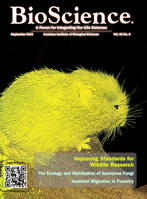Senior’s Photo Lands on National Journal Cover
A photograph taken by UALR biology senior Katherine F. Simmons of Little Rock graces the cover of the September issue of the journal BioScience, the heavily cited journal covering all biological disciplines. The photo of a hispid cotton rat as it appears under mixed ultraviolet and visible light after it has been dusted with nontoxic fluorescent powder was taken during a mammalogy class field trip in 2010.
“Researchers and students live-trap the rodents, then release them after dusting. Powder trails allow the animals’ movements to be followed using ultraviolet lights,” according to the caption accompanying the photo.
“For students, powder tracking is a vivid introduction to the habits and habitat preferences of native species. For members of institutional animal care and use committees, protocols involving capture and powder tracking highlight the different considerations associated with the ethical use of animals in wildlife research, which are distinct from those in biomedical research.”
The photo relates to an accompanying journal article by Dr. Robert Sikes, professor in the UALR Department of Biology, and his colleagues. The article argues in favor of changing Public Health Services (PHS) policy to formally recognize the taxon-specific guidelines developed by professional societies as the most appropriate standards for the care and use of wild vertebrates in research.
Sikes, who chairs the Animal Care and Use Committee of the American Society of Mammalogists, wrote the article with Ellen Paul, executive director of the Ornithological Council, and Steve Beaupre, president of the American Society of Ichthyologists and Herpetologists. Sikes also is the lead author of the “Guidelines of the American Society of Mammalogists for the Care and Use of Wild Mammals in Research.”
The authors are working to provide resources relevant to wildlife research that benefit “investigators, oversight and regulatory personnel, and – most especially – the animals themselves.”
The photo of a hispid cotton rat as it appears under mixed ultraviolet and visible light after it has been dusted with nontoxic fluorescent powder was taken during a mammalogy class field trip in 2010.
“Researchers and students live-trap the rodents, then release them after dusting. Powder trails allow the animals’ movements to be followed using ultraviolet lights,” according to the caption accompanying the photo.
“For students, powder tracking is a vivid introduction to the habits and habitat preferences of native species. For members of institutional animal care and use committees, protocols involving capture and powder tracking highlight the different considerations associated with the ethical use of animals in wildlife research, which are distinct from those in biomedical research.”
The photo relates to an accompanying journal article by Dr. Robert Sikes, professor in the UALR Department of Biology, and his colleagues. The article argues in favor of changing Public Health Services (PHS) policy to formally recognize the taxon-specific guidelines developed by professional societies as the most appropriate standards for the care and use of wild vertebrates in research.
Sikes, who chairs the Animal Care and Use Committee of the American Society of Mammalogists, wrote the article with Ellen Paul, executive director of the Ornithological Council, and Steve Beaupre, president of the American Society of Ichthyologists and Herpetologists. Sikes also is the lead author of the “Guidelines of the American Society of Mammalogists for the Care and Use of Wild Mammals in Research.”
The authors are working to provide resources relevant to wildlife research that benefit “investigators, oversight and regulatory personnel, and – most especially – the animals themselves.” View more stories in News
